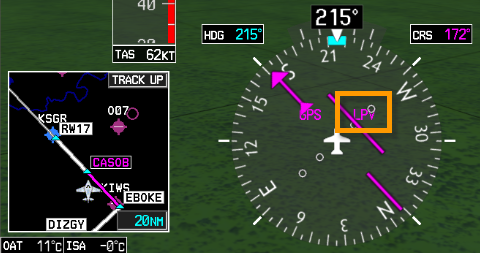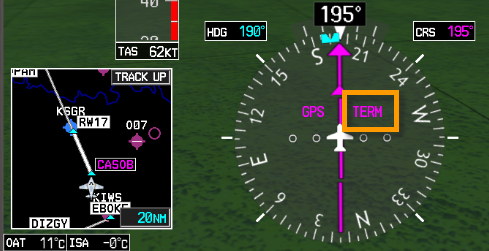The relationship between pilots and ATC is a complex one. We pilots are required to follow ATC instructions, yet we remain the ones “in command.” It works in theory, but not as well in practice. When you spend an entire flight following instructions from ATC, it’s hard to remember that the pilot always must decide whether ATC instructions are right or wrong.
There is a growing pandemic of bad instructions from ATC. It appears to have started in Texas, it has definitely spread to Colorado and now it appears to be infecting other ATC facilities. It sounds something like this:
KSGR RNAV (GPS) Rwy 17
Columbia 123CA, turn left heading 190, proceed direct CASOB, cleared for the RNAV (GPS) Rwy 17 approach.
Do you see anything wrong with those instructions?
Our aircraft is being vectored to final. As if often the case flying this approach into Sugarland, ATC kept us well southeast of EBOKE because another airport underlies that waypoint. We are being vectored to intercept final quite close to the final approach fix, CASOB.
 Most pilots at the beginning of vectors will activate the leg to CASOB, either with ACTIVATE VECTORS-TO-FINAL or by manually activating the leg. This in turn causes the approach level-of-service “LPV” to be annunciated. So at this point, the flight management system is configured correctly for the approach.
Most pilots at the beginning of vectors will activate the leg to CASOB, either with ACTIVATE VECTORS-TO-FINAL or by manually activating the leg. This in turn causes the approach level-of-service “LPV” to be annunciated. So at this point, the flight management system is configured correctly for the approach.
Then, we get the instruction from ATC:
Columbia 123CA, turn left heading 190, proceed direct CASOB, cleared for the RNAV (GPS) Rwy 17 approach.
Many pilots when receiving this instruction will attempt to follow it to the letter. They will set their heading bug to 190 and then press -D> to proceed direct to the FAF. The result looks something like this:
The needle centers before we even complete the turn to Heading 190, but more importantly, WE ARE BACK IN TERM MODE! The approach has been cancelled. If you had your eye on the attitude indicator, you would see the vertical guidance disappearing.
Why does this happen? Because one of the criteria for a GPS to enter approach mode is that the active leg must be a published leg to the final approach fix. Proceeding direct to the FAF creates a new leg from your present position; it’s not the leg from the NavData database. This effectively cancels the approach.
An ATC No-No
ATC should not be issuing instructions for you to proceed direct to the final approach fix. The guidance from FAA Order JO 7110.65U Air Traffic Control, paragraph 4-8-1 “Approach Clearance” states:
d. For RNAV-equipped aircraft operating on unpublished routes, issue approach clearance for conventional or RNAV SIAP only after the aircraft is:
1. Established on a heading or course direct to the IAF at an intercept angle not greater than 90 degrees and is assigned an altitude [to maintain until the aircraft is established on a segment of a published route or instrument approach procedure]. Radar monitoring is required for RNAV (RNP) approaches when no procedure turn or hold−in−lieu of procedure turn will be executed.
2. Established on a heading or course direct to the IF at an angle not greater than 90 degrees, provided the following conditions are met:
(a) Assign an altitude to maintain until the aircraft is established on a segment of a published route or instrument approach procedure]
that will permit a normal descent to the FAF.
(b) Radar monitoring is provided to the IF.
(c) The SIAP must identify the intermediate fix with the letters “IF.”
(d) For procedures where an IAF is published, the pilot is advised to expect clearance to the IF at least 5 miles from the fix.
3. Established on a heading or course direct to a fix between the IF and FAF, in accordance with Paragraph 5-9-1, Vectors to Final Approach Course, and Paragraph 5-9-2, Final Approach Course Interception.
Nowhere does it say ATC may send you direct to the Final Approach Fix. Direct to Initial Approach Fix (IAF)? Yes. Direct to an Intermediate Fix (IF)? Yes. Direct to the FAF? NO!
ATC’s job when vectoring to final is to give you a heading to establish you on the published final approach course prior to the final approach fix. They are not allowed to send you direct to the FAF, period.
The only reason ATC is giving you a final heading to turn to is that they are required to do so by their orders. Paragraph 5-9-2 “Final Approach Course Interception” says:
a. Assign headings that will permit final approach course interception on a track that does not exceed the interception angles specified in TBL 5−9−1.
TBL 5−9−1
Approach Course Interception Angle
| Distance from interception point to approach gate | Maximum interception angle |
|---|---|
| Less than 2 miles or triple simultaneous ILS/MLS approaches in use | 20 degrees |
| 2 miles or more | 30 degrees (45 degrees for helicopters) |
Thus, if ATC is vectoring you really close to the final approach fix, they are required to assign you a 20 degree intercept heading, whether or not it makes sense. When you get a last-second clearance like this, often the best thing to do is ignore the assigned heading and simply focus on intercepting the course.
So What Should a Pilot Do?
You have a couple options when you get a bogus clearance like the example above:
- You can tell ATC “Unable direct to final approach fix, request present heading to intercept final approach course.”
The problem with this option is that you might be starting a big long discussion right when you need to be focusing on shooting the approach.
- You can ignore the details of the approach clearance and quietly focus on intercepting the published final approach course.
This is your best option when you are already close to the final approach course or the final approach fix. Recognize that ATC has to follow a script, and sometimes the script does not make sense. Do what you need to do for your avionics to sequence onto the approach correctly.
If you are far enough away from the final approach fix that you feel compelling to fly the newly assigned heading, go ahead and do so. But in that case you should have enough time for option #1.
ATC should not be sending you direct to the final approach fix. If you follow those bogus instructions, your approach will fail. You are the Pilot-In-Command. Take command.



